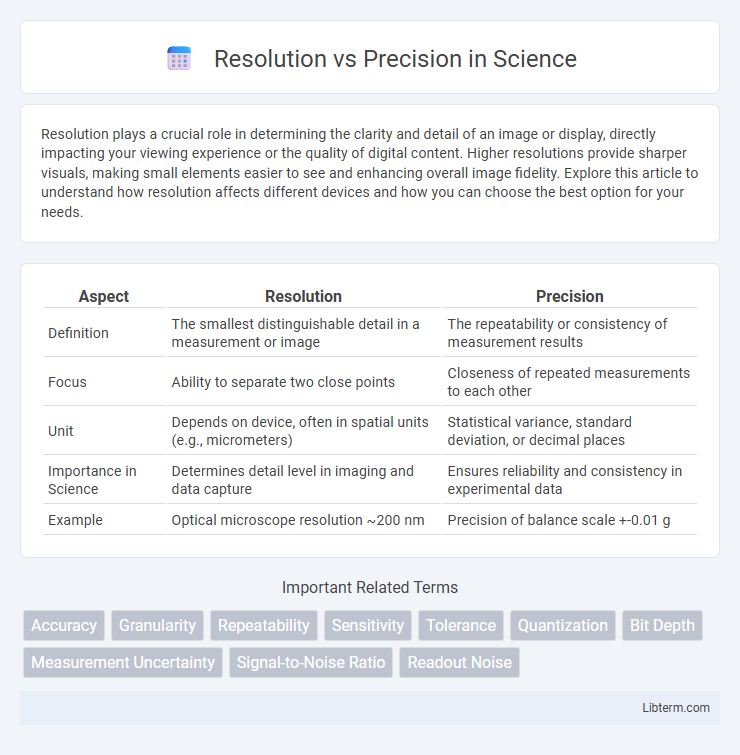Resolution plays a crucial role in determining the clarity and detail of an image or display, directly impacting your viewing experience or the quality of digital content. Higher resolutions provide sharper visuals, making small elements easier to see and enhancing overall image fidelity. Explore this article to understand how resolution affects different devices and how you can choose the best option for your needs.
Table of Comparison
| Aspect | Resolution | Precision |
|---|---|---|
| Definition | The smallest distinguishable detail in a measurement or image | The repeatability or consistency of measurement results |
| Focus | Ability to separate two close points | Closeness of repeated measurements to each other |
| Unit | Depends on device, often in spatial units (e.g., micrometers) | Statistical variance, standard deviation, or decimal places |
| Importance in Science | Determines detail level in imaging and data capture | Ensures reliability and consistency in experimental data |
| Example | Optical microscope resolution ~200 nm | Precision of balance scale +-0.01 g |
Understanding Resolution and Precision
Resolution defines the smallest measurable change a system can detect, crucial in digital imaging or measurement devices, while precision refers to the consistency and repeatability of those measurements under unchanged conditions. Understanding resolution helps in identifying the level of detail an instrument or device can capture, whereas precision indicates how reliably it produces the same measurement each time. Both resolution and precision are essential for achieving accurate, high-quality data in scientific experiments and technical applications.
Key Differences Between Resolution and Precision
Resolution defines the smallest detectable change or the finest detail a measurement instrument can distinguish, while precision measures the consistency or repeatability of measurements under unchanged conditions. Resolution is often limited by the sensor's hardware or data conversion process, such as the number of bits in an analog-to-digital converter. Precision depends on factors like measurement noise, instrument stability, and environmental conditions, making it possible to have high precision with low resolution or vice versa.
Why Resolution Matters in Measurement
Resolution defines the smallest change in a measured variable that an instrument can detect, directly impacting the clarity and detail of data. Higher resolution enables more accurate differentiation between fine variations, crucial for applications requiring precise measurement like scientific research and quality control. Precision depends on consistent reproducibility, but without adequate resolution, subtle but significant changes may be missed, compromising measurement reliability.
The Role of Precision in Data Accuracy
Precision directly impacts data accuracy by determining the consistency and exactness of measurement results in repeated trials. Higher precision reduces variability and measurement error, facilitating reliable data analysis and decision-making processes. Precision ensures data integrity by enabling finer distinctions between similar data points, which is critical in scientific experiments and quality control.
Resolution vs Precision: Common Misconceptions
Resolution and precision are often mistakenly used interchangeably, but resolution refers to the smallest detectable change in a measurement, whereas precision indicates the repeatability or consistency of measurements. A high-resolution instrument can detect minute differences, but without precision, these measurements may vary widely and lack reliability. Misunderstanding this distinction leads to incorrect assumptions about data quality and measurement accuracy in scientific and technical contexts.
Practical Examples: Resolution and Precision in Action
Digital cameras capture images with different resolutions, measured in megapixels, determining the detail level, while precision refers to consistent color accuracy across multiple shots, crucial for professional photography. In printers, resolution indicates dots per inch (DPI), affecting sharpness, whereas precision ensures exact color matching in repeated print runs for branding consistency. CNC machines execute high-resolution designs with fine details, but precision controls the accuracy of repeated movements to produce identical parts in manufacturing.
Factors Affecting Resolution in Technology
Resolution in technology is influenced by factors such as sensor quality, pixel density, and optical system design, which collectively determine the clarity and detail of an image or signal. The precision of measurement tools and algorithms plays a crucial role, as higher precision enables finer distinctions between close data points, enhancing resolution. Environmental conditions like lighting, noise levels, and signal interference also impact the effective resolution by affecting the accuracy and reliability of the captured data.
Enhancing Precision in Scientific Experiments
Enhancing precision in scientific experiments requires minimizing random errors and controlling environmental variables to achieve consistent and reproducible results. High precision allows for detecting subtle differences and validating hypotheses with greater confidence, improving the reliability of experimental data. Techniques such as instrument calibration, repeated measurements, and standardized protocols are essential for optimizing precision in research settings.
Resolution and Precision: Impact on Outcomes
Resolution determines the smallest distinguishable detail in imaging or measurement, directly influencing the clarity and accuracy of data interpretation. Precision reflects the consistency and repeatability of measurements, affecting reliability and confidence in results. High resolution combined with high precision optimizes outcomes by enabling detailed observation and dependable data that support better decision-making and analysis.
Choosing the Right Balance: Resolution or Precision
Choosing the right balance between resolution and precision depends on the specific application requirements and data characteristics. High resolution provides detailed measurement granularity, but may amplify noise, while high precision ensures consistency and repeatability, reducing measurement uncertainty. Optimizing sensor configurations or measurement systems involves trade-offs to achieve sufficient resolution without compromising the reliability of precise data outputs.
Resolution Infographic

 libterm.com
libterm.com